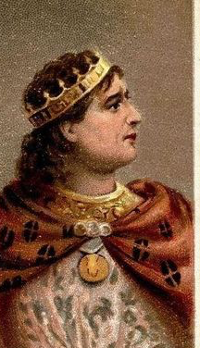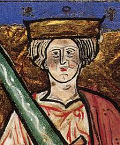King Æthelred II of England
Æthelred was just 10 when his older brother, Edward the Martyr, was murdered. As the only surviving son of Edgar the Peaceful, Æthelred was the heir to the throne of England. He became king at a time rife with challenges.  During the next decade, wave after wave of Norwegian and Swedish raiders stormed through England. King Æthelred was on the throne in 980, when Norse raids recommenced. He led a spirited defense of London at one point, but the strife continued. At one point, Æthelred decided to try to win by throwing money at the problem. This was the Danegeld, an amount of money paid by England to the Danes as a means of preventing further attacks. The king decided to pursue this strategy in 991, after a horrific defeat at the Battle of Maldon. The theory likely was that the Danes would take the money without having to fight for it, and they certainly did; but they also kept increasing the price. 
Æthelred finally had enough and declared a day on which all Danes living in England would be killed. This came to be called the St. Brice's Day massacre. The two sides continued to trade acts of violence until a large Danish force appeared, in 1013, with King Sweyn Fordbeard at the head of it, assisted by a Norwegian contingent commanded by Olaf Tryggvason. The Danes asserted themselves military once more, and Æthelred fled to Normandy, leaving the throne to Sweyn. Having gotten exactly what he wanted, Sweyn settled in to rule. He died just a few weeks later, however, and Æthelred pounced, reclaiming his throne and his land. Sweyn's son, Canute, had decided to cut his losses in 1014 and returned home. Æthelred also had assistance at this time from Norway's Olaf Haraldsson. Canute returned in 1015, when conveniently Olaf Haraldsson had gone to Continental Europe and Æthelred's own son, Edmund Ironside, had risen up against him. Canute set about conquering most of England. Edmund Ironside mended fences with his father and joined him in the defense of London. In the middle of this intense struggle, Æthelred died, on April 23, 1016. His son became King Edmund Ironside. He wasn't king of much, however. Edmund continued the fight against Canute, including a showdown at the Battle of Ashingdon, on October 18. This was a crushing victory for Canute. Edmund had demonstrated his ferocity and battle acumen to such an extent, however, that Canute was satisfied with a division of power. Edmund retained Wessex, and Canute got the rest of England. Edmund died on November 30, and Canute took the rest of England. Æthelred was buried in Old St. Paul's Cathedral. He was known on the domestic front for a large contribution to the legal code; this led, in part, to an improvement in the qualify of coinage. One area of law regarded what some historians think was the origin of the grand jury: a body of 12 thegns who would meet to discuss important matters. He was also on the throne of England for 37 years, the third-longest reign for a king (after Henry III and Edward II).
|
|



 A note on Æthelred's nickname, "Unready." It has come down into present-day English as "the Unready," as in Æthelred the Unready. Given a view of several years later, many historians would certainly conclude that Æthelred might not have been ready for the ferocity of the Danish invasions that confronted him at such a young age. However, the name was first given to him in Old English in the form of the word Unræd, which means something along the lines of "evil counsel" or "bad plan" or even "no counsel." Another interpretation of his name assigned the "red" in his name to the same word ræd, meaning "counsel" and the Æthel in his name to the equivalent of "noble." This can be seen in earlier kings, such as Æthelwulf, whose name meant "noble wolf." The moniker Unræd first appeared after Æthelred's name in the 1180s.
A note on Æthelred's nickname, "Unready." It has come down into present-day English as "the Unready," as in Æthelred the Unready. Given a view of several years later, many historians would certainly conclude that Æthelred might not have been ready for the ferocity of the Danish invasions that confronted him at such a young age. However, the name was first given to him in Old English in the form of the word Unræd, which means something along the lines of "evil counsel" or "bad plan" or even "no counsel." Another interpretation of his name assigned the "red" in his name to the same word ræd, meaning "counsel" and the Æthel in his name to the equivalent of "noble." This can be seen in earlier kings, such as Æthelwulf, whose name meant "noble wolf." The moniker Unræd first appeared after Æthelred's name in the 1180s.
